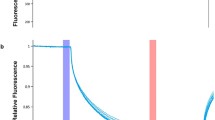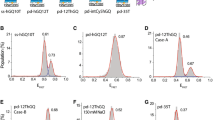Abstract
Biophysical quantification of protein interactions is central to unveil the molecular mechanisms of cellular processes. Researchers can choose from a wide panel of biophysical methods that quantify molecular interactions in different ways, including both classical and more novel techniques. We report the outcome of an ARBRE-MOBIEU training school held in June 2019 in Gif-sur-Yvette, France (https://mosbio.sciencesconf.org/). Twenty European students benefited from a week’s training with theoretical and practical sessions in six complementary approaches: (1) analytical ultracentrifugation with or without a fluorescence detector system (AUC-FDS), (2) isothermal titration calorimetry (ITC), (3) size exclusion chromatography coupled to multi-angle light scattering (SEC-MALS), (4) bio-layer interferometry (BLI), (5) microscale thermophoresis (MST) and, (6) switchSENSE. They implemented all these methods on two examples of macromolecular interactions with nanomolar affinity: first, a protein–protein interaction between an artificial alphaRep binder, and its target protein, also an alphaRep; second, a protein-DNA interaction between a DNA repair complex, Ku70/Ku80 (hereafter called Ku), and its cognate DNA ligand. We report the approaches used to analyze the two systems under study and thereby showcase application of each of the six techniques. The workshop provided students with improved understanding of the advantages and limitations of different methods, enabling future choices concerning approaches that are most relevant or informative for specific kinds of sample and interaction.






Similar content being viewed by others
Data availability
Data can be obtained by requesting the corresponding author.
Change history
27 April 2021
A Correction to this paper has been published: https://doi.org/10.1007/s00249-021-01540-6
References
Abdiche Y, Malashock D, Pinkerton A, Pons J (2018) Determining kinetics and affinities of protein interactions using a parallel real-time label-free biosensor, the Octet. Anal Biochem 377(2):209–217
Andreani J, Guerois R (2014) Evolution of protein interactions: from interactomes to interfaces. Arch BiochemBiophys 554:65–75
Asmari M, Ratih R, Alhazmi HA, El Deeb S (2018) Thermophoresis for characterizing biomolecular interaction. Methods 146:107–119
Brautigam CA (2015) Chapter five - calculations and publication-quality illustrations for analytical ultracentrifugation data. In: Cole JL (ed) Methods in enzymology. Academic Press, pp 109–133
Campanacci V, Urvoas A, Consolati T, Cantos-Fernandes S, Aumont-Nicaise M, Valerio-Lepiniec M, Surrey T, Minard P, Gigant B (2019) Selection and characterization of artificial proteins targeting the tubulin α subunit. Structure 27(3):497–506
Chang HHY, Pannunzio NR, Adachi N, Lieber MR (2017) Non-homologous DNA end joining and alternative pathways to double-strand break repair. Nat Rev Mol Cell Biol 18(8):495–506
Chevrel A, Mesneau A, Sanchez D, Celma L, Quevillon-Cheruel S, Cavagnino A, Nessler S, Li de la Sierra-Gallay I, van Tilbeurgh H, Minard P, Valerio-Lepiniec M, Urvoas A (2018) Alpha repeat proteins (αRep) as expression and crystallization helpers. J StructBiol 201(2):88–99
Di Meo T, Ghattas W, Herrero C, Velours C, Minard P, Mahy JP, Ricoux R, Urvoas A (2017) αRep A3: a versatile artificial scaffold for metalloenzyme design. Chemistry 23(42):10156–10166
Fernandez M, Urvoas A, Even-Hernandez P, Burel A, Mériadec C, Artzner F, Bouceba T, Minard P, Dujardin E, Marchi V (2020) Hybrid gold nanoparticle-quantum dot self-assembled nanostructures driven by complementary artificial proteins. Nanoscale 12(7):4612–4621
Folta-Stogniew E (2006) Oligomeric states of proteins determined by size-exclusion chromatography coupled with light scattering, absorbance, and refractive index detectors. Methods MolBiol 328:97–112
Freire E, Schön A, Velazquez-Campoy A (2009) Isothermal titration calorimetry: general formalism using binding polynomials. Methods Enzymol 455:127–155
Frit P, Ropars V, Modesti M, Charbonnier JB, Calsou P (2019) Plugged into the Ku-DNA hub: the NHEJ network. ProgBiophysMolBiol 147:62–76
Gontier A, Varela PF, Nemoz C, Ropars V, Aumont-Nicaise M, Desmadril M, Charbonnier JB (2021) Measurements of protein-DNA complexes interactions by isothermal titration calorimetry (ITC) and microscalethermophoresis (MST). Methods MolBiol 2247:125–143
Guellouz A, Valerio-Lepiniec M, Urvoas A, Chevrel A, Graille M, Fourati-Kammoun Z, Desmadril M, van Tilbeurgh MP (2013) Selection of specific protein binders for pre-defined targets from an optimized library of artificial helicoidal repeat proteins (alphaRep). PLoS ONE 8(8):e71512
Holdgate GA (2001) Making cool drugs hot: isothermal titration calorimetry as a tool to study binding energetics. Biotechniques 31(1):164–170
Jerabek-Willemsen M, Wienken CJ, Braun D, Baaske P, Duhr S (2011) Molecular interaction studies using microscalethermophoresis. Assay Drug Dev Technol 9(4):342–353
Knezevic J, Langer A, Hampel PA, Kaiser W, Strasser R, Rant U (2012) Quantitation of affinity, avidity, and binding kinetics of protein analytes with a dynamically switchable biosurface. J Am ChemSoc 134(37):15225–15228
Krell T (2008) Microcalorimetry: a response to challenges in modern biotechnology. MicrobBiotechnol 1(2):126–136
Léger C, Di Meo T, Aumont-Nicaise M, Velours C, Durand D, Li de la Sierra-Gallay I, van Tilbeurgh H, Hildebrandt N, Desmadril M, Urvoas A, Valerio-Lepiniec M, Minard P (2019) Ligand-induced conformational switch in an artificial bidomain protein scaffold. Sci Rep 9(1):1178
Léger C, Yahia-Ammar A, Susumu K, Medintz IL, Urvoas A, Valerio-Lepiniec M, Minard P, Hildebrandt N (2020) Picomolarbiosensing and conformational analysis using artificial bidomain proteins and terbium-to-quantum dot förster resonance energy transfer. ACS Nano 14(5):5956–5967
Loiseau L, Fyfe C, Aussel L, Hajj Chehade M, Hernández SB, Faivre B, Hamdane D, Mellot-Draznieks C, Rascalou B, Pelosi L, Velours C, Cornu D, Lombard M, Casadesús J, Pierrel F, Fontecave M, Barras F (2017) The UbiK protein is an accessory factor necessary for bacterial ubiquinone (UQ) biosynthesis and forms a complex with the UQ biogenesis factor UbiJ. J BiolChem 292(28):11937–11950
Nemoz C, Ropars V, Frit P, Gontier A, Drevet P, Yu J, Guerois R, Pitois A, Comte A, Delteil C, Barboule N, Legrand P, Baconnais S, Yin Y, Tadi S, Barbet-Massin E, Berger I, Le Cam E, Modesti M, Rothenberg E, Calsou P, Charbonnier JB (2018) XLF and APLF bind Ku at two remote sites to ensure DNA repair by non-homologous end joining. Nat StructMolBiol 25(10):971–980
Prasad J, Viollet S, Gurunatha KL, Urvoas A, Fournier AC, Valerio-Lepiniec M, Marcelot C, Baris B, Minard P, Dujardin E (2019) Directed evolution of artificial repeat proteins as habit modifiers for the morphosynthesis of (111)-terminated gold nanocrystals. Nanoscale 11(37):17485–17497
Raynal B, Lenormand P, Baron B, Hoos S, England P (2014) Quality assessment and optimization of purified protein samples: why and how? Microb Cell Fact 13:180
Schuck P (2000) Size-distribution analysis of macromolecules by sedimentation velocity ultracentrifugation and lamm equation modeling. Biophys J 78:1606–1619
Tadi SK, Tellier-Lebegue C, Nemoz C, Drevet P, Audebert S, Roy S, Meek K, Charbonnier JB, Modesti M (2016) PAXX is an accessory c-NHEJ Factor that associates with Ku70 and has overlapping functions with XLF. Cell Rep 17(2):541–555
Valerio-Lepiniec M, Urvoas A, Chevrel A, Guellouz A, Ferrandez Y, Mesneau A, de la Sierra-Gallay IL, Aumont-Nicaise M, Desmadril M, van Tilbeurgh H, Minard P (2015) The αRep artificial repeat protein scaffold: a new tool for crystallization and live cell applications. BiochemSoc Trans 43(5):819–824
Vega S, Abian O, Velazquez-Campoy A (2015) A unified framework based on the binding polynomial for characterizing biological systems by isothermal titration calorimetry. Methods Apr 76:99–115
Velazquez-Campoy A, Freire E (2006) Isothermal titration calorimetry to determine association constants for high-affinity ligands. Nat Protoc 1(1):186–191
Walker JR, Corpina RA, Goldberg J (2001) Structure of the Ku heterodimer bound to DNA and its implications for double-strand break repair. Nature 412(6847):607–614
Wyman J, Gill SJ (1990) Binding and linkage: Functional chemistry of biological macromolecules. University Science Books, Mill Valley
Zhao H, Brautigam CA, Ghirlando R, Schuck P (2013) Overview of current methods in sedimentation velocity and sedimentation equilibrium analytical ultracentrifugation. CurrProtoc Protein Sci 71:20
Acknowledgments
We thank members of Philippe Minard’s and Jean-Baptiste Charbonnier’s teams at I2BC for the sample preparation, Bruno Baron and Bertrand Raynal from Institut Pasteur, Paris for all their expert advices in molecular scale biophysics, and Eric Ennifar from Institut de Biologie Moléculaire et Cellulaire, Strasbourg for sharing its expertise in the study of biomolecular machineries using biophysical approaches. Friederike Möller and Hanna Müller-Landau from Dynamic Biosensors, Aymeric Audfray from Malvern Panalytical, Mathilde Belnou from NanoTemper technologies, and Stephanie Bourgeois and coworkers from Fluidic Analytics for their availability and all the fruitful discussion. We kindly thank all the participants to the MoSBio Training School, all the sponsors without whom this successful event had not been possible, and finally the keynote speakers, Julie Ménétrey and Terence Strick who shared their projects with us. Most of preparatory experiments were performed in the I2BC, PIM platform (https://www.pluginlabs-universiteparissaclay.fr/fr/results/keywords/PIM), while some others were performed in Institut Pasteur, PFBMI platform. Finally, we thank ARBRE-MOBIEU network for its support to publish this article.
Funding
JBC is supported by ARC program (SLS220120605310), French Infrastructure for Integrated Structural Biology (FRISBI) ANR-10-INSB-05, ANR-18-CE44-0008, ANR-20-CE11-0026, INCA 2016-1-PL BIO-11 and INCA SLX4 INCA 2016-159.
Author information
Authors and Affiliations
Contributions
PFV, PE, SU, CE, AVC, AR, JBC authors contributed to the study conception and design. Material preparation, data collection and analysis were performed by CV, MAN, SU, PE, AVC, DS, GB, PS, CQ, CE, AR. The first draft of the manuscript was written by PFV and all authors commented on previous versions of the manuscript. All authors read and approved the final manuscript.
Corresponding author
Ethics declarations
Conflict of interest
The authors declare no competing interest. Pierre Soule (NanoTemper) and Christophe Quétard (FortéBio) helped during the training without commercial interest.
Ethical approval
Not applicable.
Consent to participate
The authors consent to participate to this project.
Consent for publication
The authors consent to publish the work reported in this paper.
Additional information
Publisher's Note
Springer Nature remains neutral with regard to jurisdictional claims in published maps and institutional affiliations.
The original online version of this article was revised: Due to corrections in Figures. In Fig. 2, the size of the subtitles a to g is reduced; In Fig 3b, “1DNA_1Ku70/Ku80” has been changed to “1DNA-1Ku70/Ku80” and In Fig 4, “50µg” has been changed to “50ng” in the MST cell at the bottom of the table.
Special Issue: COST Action CA15126, MOBIEU: Between atom and cell.
Supplementary Information
Below is the link to the electronic supplementary material.
Rights and permissions
About this article
Cite this article
Velours, C., Aumont-Nicaise, M., Uebel, S. et al. Macromolecular interactions in vitro, comparing classical and novel approaches. Eur Biophys J 50, 313–330 (2021). https://doi.org/10.1007/s00249-021-01517-5
Received:
Revised:
Accepted:
Published:
Issue Date:
DOI: https://doi.org/10.1007/s00249-021-01517-5




